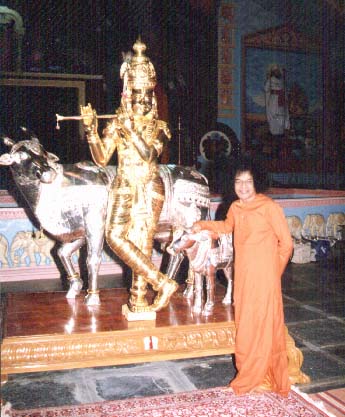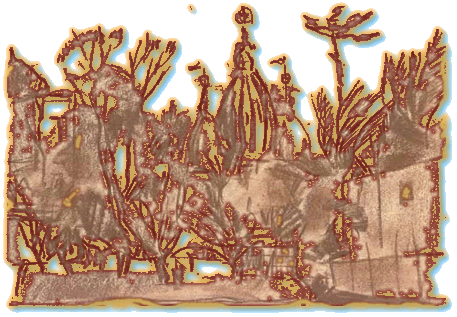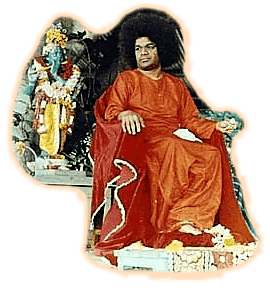
" Listen to this chapter sung! "
[Slokas 5 to 10, 16 to 20] "
" Listen to this spoken
chapter in Audio "
Verse 1.
śrī-bhagavān uvāca
param bhūyah pravakshyāmi
jñānānām jñānam uttamam
yaj jñātvā munayah sarve
parām siddhim ito gatāh
As
fog
before
the sun, ignorance melts away before knowledge. Knowledge is
acquired by uninterrupted inquiry. One should constantly be engaged in
the inquiry of the nature of Brahman; the reality of the I, the
transformations that occur to the individual at birth and at death and
such matters. As you remove the husk that covers up the rice, so too
the ignorance that adheres to the mind has to be removed by the
frequent application of the abrasive, atmic inquiry. It is only when
full knowledge is won that one can get liberated, or, in other words
attain moksha (liberation or mukti: the final liberation from
material existence meaning that one restores one's eternal bond with
Krishna in arriving at devotional service unto Him). After the
attainment of the above said atmic knowledge, one has to follow the
path of Brahman and act according to the new wisdom. - Jñāna Vahini, p. 1
Verse 2.
idam jñānam
upāśritya`
mama sādharmyam āgatāh
sarge 'pi nopajāyante
pralaye na vyathanti ca
Verse 3.
mama yonir
mahad brahma
tasmin garbham dadhāmy aham
sambhavah sarva-bhūtānām
tato bhavati bhārata
Verse 4.
sarva-yonishu
kaunteya
mūrtayah sambhavanti yāh
tāsām brahma mahad yonir
aham bīja-pradah pitā
Verse 5.
sattvam
rajas tama iti
gunāh prakriti-sambhavāh
nibadhnanti mahā-bāho
dehe dehinam avyayam
Nature
is
composed
of three basic gunas or qualities, sattvic (goodness),
rajasic
(passion), tamasic (ignorance), and their
interplay
determines the nature and moods of human beings at different intervals
of times due to the predominance of one or the other. - Summer
Showers
in
Brindavan 1973, p. 198.
Verse 6.
tatra
sattvam nirmalatvāt
prakāśakam anāmayam
sukha-sangena badhnāti
jñāna-sangena cānagha
In
fact,
the
best of the three gunas or qualities is the sattva
and that itself promotes bhakti or devotion and is the best sādhana
(devotion, spiritual discipline). What I am telling you
is the simple and elemental truth. - Summer Roses on the Blue
Mountains 1976, p. 1.
Verse 7.
rajo
rāgātmakam viddhi
trishnā-sanga-samudbhavam
tan nibadhnāti kaunteya
karma-sangena dehinam
Without
getting
rid
of your rajoguna and of your temper, how are you
going to take any interest in the spiritual aspects? - Summer
Roses
on
the Blue Mountains 1976, p. 1.
Verse 8.
tamas tv
ajñāna-jam viddhi
mohanam sarva-dehinām
pramādālasya-nidrābhis
tan nibadhnāti bhārata
Without
getting
rid
of your tamoguna and of your anger, how are you
going to understand the spiritual background? - Summer Roses on the Blue Mountains 1976, p. 1.
Verse 9.
sattvam
sukhe sañjayati
rajah karmani bhārata
jñānam āvritya tu tamah
pramāde sañjayaty uta
The
three
gunas represent the three aspects of human nature. Rajoguna
is the attachment that brings about desires and creates eagerness to
enjoy the objective world that is "seen"; it breeds desire for physical
heavenly pleasure. Tamoguna cannot grasp the reality; so it
misunderstands easily and takes the false to be the true. It lands
persons into negligence and error. It binds, instead of releasing. Sattvaguna
controls the cause of grief and sorrow; encourages people to follow the
path of real joy and happiness. Therefore, being single-pointed and
unaffected by either of these three is the basis for purity and
steadfastness. - Gītā Vahini, p. 193.
Verse 10.
rajas
tamaś cābhibhūya
sattvam bhavati bhārata
rajah sattvam tamaś caiva
tamah sattvam rajas tathā
The
three
gunas, sattva, rajas, and tamas,
undergo
various permutations and combinations and modifications and become
manifested as all this creation, this universe, this prakriti
(the material nature with the living beings). Therefore, this prakriti
is subject to changes, it is not fixed, true. But the ātmā
is chaitanya (consciousness, intelligence)
which is tejorupam, sheer effulgence; so it is not subject to
blemishes or modifications. The body is prakriti; buddhi
(intellect) and manas ( feeling, mind) are also prakriti;
for
this
reason, they too differ according to the degree or excess or
deficiency of one or other of the gunas. - Gītā Vahini, p. 195.
Verse 11.
sarva-dvāreshu
dehe
'smin
prakāśa upajāyate
jñānam yadā tadā vidyād
vivriddham sattvam ity uta
Sattvaguna
is steady, pure, unselfish, light; so those who have this
characteristic will have no wish or want; they will be fit for the
knowledge of the ātmā. - Gītā
Vahini,
p.
195.
Verse 12.
lobhah
pravrittir ārambhah
karmanām aśamah sprihā
rajasy etāni jāyante
vivriddhe bharatarshabha
Those
with
rajoguna will be engaged in acts tarnished with a
tinge of
ego. They may have the urge to do service to others, but that urge will
drive them on to win fame and take pride in their achievements. They
will yearn for their own good, along with the good of others. - Gītā Vahini, p. 195.
Verse 13.
aprakāśo
'pravrittiś ca
pramādo moha eva ca
tamasy etāni jāyante
vivriddhe kuru-nandana
Those
who
are
endowed with tamoguna are overcome by the darkness of
ignorance, so they grope about, not knowing what is right and what is
wrong. - Gītā Vahini, p. 195.
Arjuna
is
addressed
in the Bhagavad Gītā by śrī Krishna as kuru-nandana
(son of Kuru); kuru means karma; the
expression means that one is the product of one's karma or
activities, one is shaped inevitably by the words and deeds and
thoughts that one indulges in. As long as one has a trace of ajñāna,
one
is
kuru-nandana; so, Krishna addressed Arjuna thus in
order
to entice him into the realm of bhakti and jñāna, from
the region of karma. - Sathya Sai Speaks V, p. 6.

Verse 14.
yadā sattve
pravriddhe tu
pralayam yāti deha-bhrit
tadottama-vidām lokān
amalān pratipadyate
Verse 15.
rajasi
pralayam gatvā
karma-sangishu jāyate
tathā pralīnas tamasi
mūdha-yonishu jāyate
Verse 16.
karmanah
sukritasyāhuh
sāttvikam nirmalam phalam
rajasas tu phalam duhkham
ajñānam tamasah phalam
Politeness, humility,
and forbearance are sattvic qualities; shyness, fear and
indolence are tamasic qualities; and aggressiveness,
wilfullness and envy are rajasic qualities. - Summer Showers in Brindavan 1979, p. 146.
Verse 17.
sattvāt
sañjāyate jñānam
rajaso lobha eva ca
pramāda-mohau tamaso
bhavato 'jñānam eva ca
Verse 18.
ūrdhvam
gacchanti sattva-sthā
madhye tishthhanti rājasāh
jaghanya-guna-vritti sthā
adho gacchanti tāmasāh
The
sattva guna is a golden rope, the rajoguna a
copper rope and the tamoguna, an iron rope; all three bind
effectively in spite of the difference in the cost of material. As
bonds, all three are obstacles to freedom of movement. - Gītā Vahini, p. 197.
Verse 19.
nānyam
gunebhyah kartāram
yadā drashthānupaśyati
gunebhyaś ca param vetti
mad-bhāvam so 'dhigacchati
The
human
mind
is activated into a dynamic equilibrium by the three gunas
of sattva, rajas and tamas (equanimity, energy
and inertia). These gunas are the motivating forces whose
source is īśvara who is not only transcendental but also
immanent and ubiquitous (present, appearing, or found everywhere). - Summer Showers in Brindavan 1979, p. 69.
Verse 20.
gunān etān
atītya trīn
dehī deha-samudbhavān
janma-mrityu jarā-duhkhair
vimukto 'mritam aśnute
The
common
man
is enslaved by his gunas or attributes. He should
transcend the gunas and transform himself into a divine being.
He should undergo a spiritual metamorphosis, as it were. The
spiritualization or divinization of man is the ultimate goal of the Gītā.
- Summer Showers in Brindavan 1979, p. 65.
Verse 21.
arjuna uvāca
kair lingais trīn gunān etān
atīto bhavati prabho
kim ācārah katham caitāms
trīn gunān ativartate
Verse 22-25.
śrī-bhagavān
uvāca
prakāśam ca pravrittim ca
moham eva ca pāndava
na dveshthi sampravrittāni
na nivrittāni kānkshati
[to
verse
22]: Everyone should recognize the truth that
pleasure is but an interval between two pains and face the trials and
tribulations of the world in a calm and collected manner. The
alternating experiences of pleasure and pain actually prod us along the
path of righteousness. - Summer Showers in Brindavan
1979, p. 157.
udāsīnavad
āsīno
gunair yo na vicālyate
gunā vartanta ity evam
yo 'vatishthhati nengate
[to verse 23]: Lord Krishna said: "Think of this
one point; then the whole problem will become clear. Man is happy at
one time, miserable at another; he is afraid one moment and courageous
at another." Why? Because he is shaped by the gunas. Do you say
no? Then how can you explain these changes? They alone can transform
man from one phase to another like this. "If the three gunas, sattva,
rajas and tamas, are equally balanced, then there will be
no change in him." - Gītā Vahini, p. 193.
sama-duhkha-sukhah
sva-sthah
sama-loshthāśma-kāñcanah
tulya-priyāpriyo dhīras
tulya-nindātma-samstutih
mānāpamānayos
tulyas
tulyo mitrāri-pakshayoh
sarvārambha-parityāgī
gunātītah sa ucyate
[to
verse
25]: Samajika samatva, or the equanimity that man as
an integral part of society should possess, comes next. Society too
subjects man to the dual experiences of joy and sorrow. For instance,
both praise and blame come to man from the society in which he lives.
Praise and blame are like the two faces of the same coin and they
always haunt each other. We should be perturbed by neither. We should
regard both adulation and censure as stepping stones to progress. - Summer Showers in Brindavan 1979, p. 157.
Verse 26.
mām ca yo
'vyabhicārena
bhakti-yogena sevate
sa gunān samatītyaitān
brahma-bhūyāya kalpate
On
account
of
the primary impulse of delusion and ignorance, the gunas
arose and got intermixed, and time manifested with the change, and all
this multiplicity called the universe appeared. So, the jīvi
must dedicate himself to the Master of this delusion, the director of
this play, and manipulator of this time, the actor who sports the gunas
(types of behaviors, groups of qualities, bundles of
attributes), the mother of all the worlds (māyā); he must fill
himself with understanding of the immeasureable power and glory of the
Imperishable Absolute (akshara (syllable, letter) parabrahma
(universal absolute)); he must immerse himself in the
bliss derivable therefrom. - Bhagavatha Vahini, chapter 33.
Verse 27.
brahmano hi
pratishthhāham
amritasyāvyayasya ca
śāśvatasya ca dharmasya
sukhasyaikāntikasya ca
In
the
Gītā it is declared "I am the basis of Brahman,
of
positive
immortality, of timeless dharma, and eternal bliss."
The sloka is in Chapter 14, the 27th sloka.
It
is this amrita-dharma that is described in the Upanishads,
the
same
is emphasized in the Gītā too. The dharmic way of life is the
very breath; it is the road to self-realization. Those who walk along
it are dear to the Lord; He dwells with all that are truthful, whose
deeds spring from dharma. That is why the Gītā teaches
Arjuna to develop certain qualities, which help the practise of the atmic
dharma. - Dharma Vahini, p. 17

|






